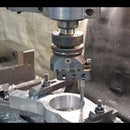Introduction: Sensors for a Flow Bench.
A flow bench in this application is a device for measuring air flow though IC engine inlet and exhaust ports and valves. These can take many forms ranging from expensive commercial offerings down to DIY examples of dubious quality. However, with modern low cost sensors of various types it is entirely feasible for DIY examples to be the equal of commercial machines. There is nothing that is difficult to make and high skill is not required. The photos above show the bench that I made and which forms the centre of this Instructable.
This document is not about making a flow bench but it is about the instrumentation and sensors that I use on my own bench. A flow bench uses some kind of vacuum source, although vacuum is an exaggeration because the sucking depression is most often below 28” water gauge which is 1 psi or ~7000 Pa.
There are only two essential parameters that need measuring in order to calculate the volumetric air flow, both are differential pressure measurements. One is the depression pressure which causes air to flow through the engine port, in other words that is a measure of the amount of “suck”. The other is differential pressure across a flow restriction to measure the actual flow. An orifice plate is the most used but I prefer a venturi tube because it is more efficient. The principal is same regardless of the nature of the restriction. Turbine meters and MAPs (Manifold Absolute Pressure) sensors rescued from modern cars are also used but these are not so prevalent and I will not be discussing those.
There are several other parameters and matching sensors that can enhanced the utility of a flow bench, such as temperature, and I will look at each in the following steps.
Supplies
Materials;
Various sensors as described in the individual steps.
Vero board or copper clad board for printed circuit.
Various resistors, capacitors and other electronic components used in simple circuits.
A form of data acquisition. I use a LabJack but hobby micros like the Arduino or Pi would be suitable.
A PC, I use a laptop with Windows.
Solder.
Tools;
Soldering iron.
The usual collection of tools for making circuits such as wire cutters/strippers etc.
Step 1: Differential Pressure Sensors
I use those illustrated. Data sheets and other info can be found at www.analogmicro.de . These sensors can output their readings either as an analog voltage signal or through an IC2 bus. I use the analog output.
They measure differential pressure, which requires two pressure inputs, that is they output a value which is the difference in pressure between the two inputs. The sketch shows that one sensor is connected to two tappings on a venturi to measure the actual flow. Another sensor measures the depression in the plenum. This is referenced to ambient barometric pressure and so one tapping is left open to the atmosphere.
These two sensors alone are enough to provide useful flow measurements, but the results are affected by environmental conditions and for repeatability it is necessary to adjust the readings using barometric pressure, temperature and relative humidity.
Step 2: Temperature Sensors
I use two of these. They are of the semiconductor type, LM34, which I encase in epoxy inside an aluminium housing for ruggedness. I attach one to the flow measuring venturi and the other to the cylinder head being measured. The pictures show this better than words can. The first picture shows one strapped onto the venturi, note also the pressure tappings which go on to the pressure sensors in the previous step.
Step 3: Humidity and Barometric Pressure Sensors.
These are mounted on a board along with various connections to other sensor and power supply as well as connecting to a LabJack which I use to collect the sensor outputs and send the data to a PC for analysis.
Step 4: Swirl Meter.
Flow through a port is not the only parameter of interest which we can measure with a flow bench if we have the right sensors. Swirl is a measure of the rotational aspect of the air flow into an engine. It is of interest because swirl helps to mix the fuel with the air and affects engine combustion.
I made an impeller which after a settling period spins at close to the RPM of the gas swirl. On the other end of the shaft is a notched wheel. The notch movements is sensed by two optical gap type sensors. I use two because with appropriate positioning they provide the A and B signals of a quadrature encoder. This allows my software to calculate RPM and direction. The oscilloscope image shows the output of the two sensors.
Step 5: A Tool for a Sensor.
This step is not about a sensor as such but a local flow velocity measuring tool which is connected to a third pressure sensor. It is a pitot tube like the devices used on aircraft to measure air speed. It is bent 180 degs. so that it can be inserted down inside a port and measure local velocities to built up a map of the velocity distribution in different parts of the port.
Step 6: Putting It All Together.
I mentioned that I use a LabJack (labjack.com) to collect the data. This is a sensibly priced data acquisition system which sends data back to a PC and receives instructions from the PC. I have connected most of the LabJack inputs etc. to a D25 connector which allows me to quickly change it from job to job.
All of the sensor outputs are brought into a dedicated box (an RS components project box.) for protection and provide a single location for a cable to connect to the LabJack. The pressure sensors are contained in this box also.
Step 7: How Everything Is Connected.
Here are some rough circuit sketches that I made for a friend. Maybe not neat or comprehensive but they show the general layout. They presented here on a FWIW basis.
Step 8: Software.
I wrote some software in Delphi (Pascal for Windows) to control the data collection by the LabJack and provide data processing features. The photos are screen shots of a couple of windows. The first shows how the data is tabulated and plotted. The LabJack comes with windows drivers which make it easy to include control features in your own programmes. The LabJack has two methods of sending data, the first is what I call "ask and receive" . The PC software asks for data and the LabJack sends it. That is the mode that I use with the flow bench. The other mode is "streaming" and is faster, data is sent continuously and only needs asking at the start. I use that mode on my shock dyno which is briefly described in another recent Instructable which can be found at
https://www.instructables.com/id/A-Basic-Course-on-Data-Acquisition/

Participated in the
Sensors Contest













